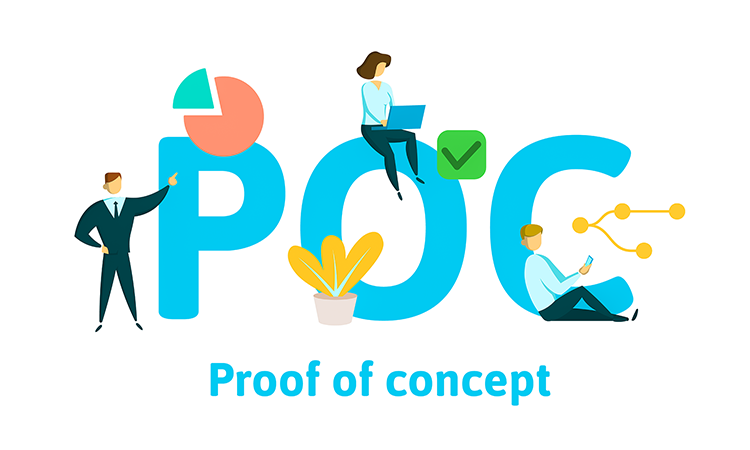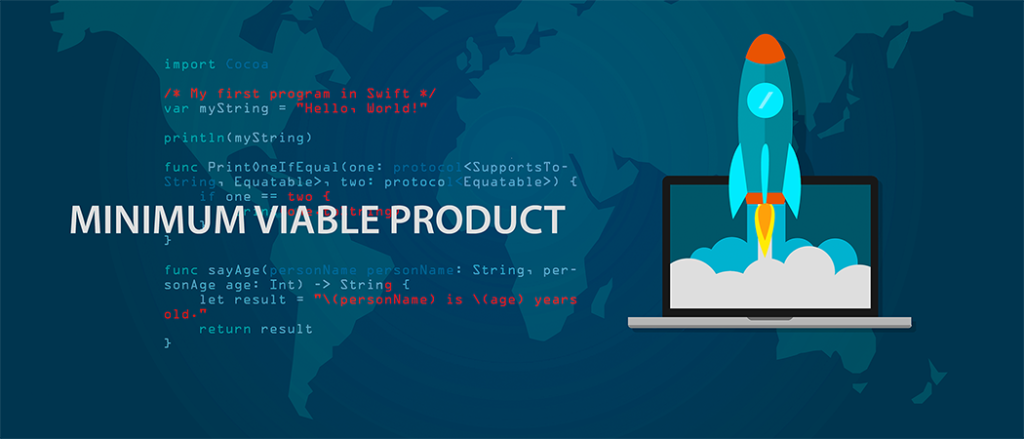Reality check is a powerful preventive method for avoiding business failures in various branches.
The software development industry is no exception. Software engineers, QA specialists, company founders, marketers, and other interested parties often come up with product (and) development ideas. At least, that’s the case at BrightMarbles Group Holding.
The potential obstacle here could be the fact that this world is too small for all the ideas we can generate. No matter how unique and wonderful our vision is, it won’t work unless the clients and potential users need it.
This is where proof of concept (PoC) takes the floor. It’s an effective way of identifying whether your concept is feasible in practice, plus, you’ll know what to do afterward.
Now, let’s define PoC, unravel why it’s important, and draw the steps to creating one.
What Is Proof of Concept?

A proof of concept (PoC) in software development is a confirmation strategy used at the beginning of the software development lifecycle. The main objective of any PoC procedure is to check whether your software concept has practical implementation and use in real life. In even more simple terms: it’s software with an addition of some practical services that you think people will buy and use.
Skipping the PoC stage might result in developing a software solution that fulfills neither the market demands nor the necessary functionalities. It could mean losing investments and wasting time and, eventually, driving your freshly launched business into the ground.
As a rule of thumb, a product’s design must meet certain demands of the market on top of being meticulously coded, tested, and executed.
BM Insight: Proof of concept is a must to prepare a complete software development round. If you want to extend your knowledge of the components in the software development lifecycle, read our guide Scratch to Full Stack: The Business Lifecycle of Software Development.
PoC and Stakeholders
In an ideally arranged PoC phase, all the stakeholders should gather to work on the vision of the once-to-be final product and its purpose. The investors and/or clients, in-house IT crew, C-suiters, and all other relevant players are expected to cover the opportunities and threats, as well as the potential boundaries the product may face. Finetuning the dev process itself, the engineering team, and testing are the three must-execute features here.
The PoC Format
The PoC format depends on the stakeholders’ preferences. For instance, if part of a software product pitch, you can create a written document or full-scale PP presentation, with various graphic details.
Most commonly, a PoC is either a document, a demo, or some sort of presentation. While there’s sometimes no programming in this period, your concept should contain all the necessary documentation and technical specifications.
This less appealing segment is better defined internally, only to get before the external stakeholders with a ready-made story.
BM Insight: As you’re ideating the proof of concept, remember that you’ll need to put together a project pitch, once you decide to sell the service/product in question. Creating PoC with a pitch in mind will save you some time afterward as you’re preparing this presentation. We bring a full-fledged guide to pitching in the free world in our post The Art of Crafting a Software Development Project Pitch.
How Does PoC Differ from Prototype and MVP?

No, we won’t be discussing Nikola Jokić in this paragraph. What we’re talking about here is PoC in comparison with the prototype and the minimum viable product (MVP) because this distinction might confuse some readers.
So, PoC is a product in its conceptual, imaginary chapter. Let’s say you want to make an ecommerce plugin for online shoe sellers. It would help e-shop owners and buyers personalize the shopping experience, enhancing the customer journey.
A prototype is the tangible iteration of the product in question, but there’s only one example or version. In the example below, it would be the raw version of the shoe-shopping customization app.
Hedge: prototypes are typically more related to tangible products than software but we’re covering the whole theoretical range.
The MVP stage comes later, when all the product’s features and its applicability have been polished. The minimum viable product is the first iteration of the conceived solution – the one you can present to your focus/test groups, clients, and investors. In this case, it would refer to the app without the initial issues, but still not ready for a wider commercial launch.
BM Insight: Every software development process has its technical and its business aspect. They’re intertwined and mutually dependent so that none of them can function successfully on its own. As a holding, we always do our homework and meticulously finetune our engineering and operating skills as we grow. That’s the only safe road to long-lasting, evergreen excellence. Our community and marketing expert Svetlana Kosić talks more about it in her blog post Excellence – The Driving Force Behind Our Company’s Growth.
Three PoC Types
According to influential sales strategist Michael Humblot, there are three types of proof of concept:
Customer-Oriented PoC
Checking how potential customers would potentially interact with the product in question. Typically, you choose a few types of audience and the same number of features to test how each segment would use every feature.
Use Case PoC
You need to convince the potential buyer/investor that the software will bring the expected benefits. Doing a use case will help them understand if the return on their investment will be satisfactory. As they see the practical use of the projected product, they’ll make the right decision, plus, you’ll also see in practice whether it works for both of you.
PoC Technical Check
Every company has its own internal software systems with mutually connected units. Integrating a new solution that’s supposedly going to improve the existing system requires a proper technical check. Your in-house team and the company tech stack should work together to confirm everything fits in properly. Conversely, this inspection will detect the potential issues so that you can eliminate them by the prototype and MVP stage.
BM Insight: You can initiate a softdev collaboration on different grounds. Sometimes clients will opt for your software product, and some other times they’ll take your solution, only to customize it with their internal team. Also, you can provide a dedicated team of software engineers to monitor the product implementation or carry out other software services for that very client. Find out more about this third option from our blog post The ABCs of Dedicated Teams on Software Development Projects.
Why Do I Need a PoC?

Every product, tangible and digital, originates from an idea. But not all ideas are morphed into desirable and useful products, to users’, clients’, and developers’ satisfaction.
It’s the PoC stage that sets apart potentially lucrative products from those that don’t see the light of day. Now, let’s explain why you need a thoroughly executed PoC stage:
- Amplifying investment potential. The more information a client gets about the potential product, the more likely they are to put their money in it. PoC is the gateway through which those assets will enter your business.
- Rational budgeting. Every investment demands a budget breakdown. The PoC stage is here to convince all the stakeholders that you’ll spend the assets rationally on a product that makes a difference.
- In-depth planning. Both you and the interested parties need to visualize the product development. PoC allows you to draft a persuasive and applicable action plan and win over substantial assets and shareholders.
- Dodging the obstacles. The more particularities you specify before the journey starts, the fewer surprises will come up along the way. Preparing outstanding PoC will hence help you dodge such obstacles.
- Timely workforce allocation. If the conceived software solution has practical potential, you can find, hire, and allocate the workforce in a timely manner.
- Full-scale discussion. On top of all the above, let all the stakeholders have a word, express their opinions, and take an active role in the entire project. Make sure to explain yourself regarding every suggestion you accept or decline.
From Ideation to PoC Creation in 5 Easy Pieces

After the theoretical introduction and feature division, let’s go through the five critical points for producing comprehensive PoC:
- Putting Problem & Solution in the Spotlight
Investors invest their assets in products that resolve some existing problem. Without pinpointing a practical issue, there’s no need for an investment. At the end of the day, sponsors expect a return on their investment.
Therefore, define the problem that your solution is going to heal, supported with some reliable data, to show there’s a market gap worth bridging. Website questionnaires, conversations with focus groups, and interviews with relevant niche experts are methods for collecting valuable intel.
BM Insight: At the holding level, we believe in the power of well-conducted professional interviews. By this, we don’t refer only to interviewing potential job candidates, but communicating with our clients, partners, and managers. Our CEO Boris Berat has shared some game-changing niche trends and company decisions in his recent interview, conducted by the BrightMarbles’ CXO Nevena Nemeš.
- Listing the Resources and Budget
What are the offline and online resources necessary to breathe life into the PoC in question? For tangible products, list the machines and raw materials. For software solutions, state what technologies, programming languages, security protocols, and expertise you’ll need to make things work.
Give a rough budget estimate, so that the interested parties know the project calculation from day one.
- Defining the KPIs
Every investor, client, or stakeholder wants to know how you’ll measure the success of the product in question.
If we start with the assumption there’s a relevant market need – which would be great for your idea – think of the metrics and criteria that would specify your product as successful. For the shoe-selling plugin from the above, those KPIs could be the number of downloads within a certain interval, or the revenue generated through in-app ads.
Leave room for the other relevant entities to express their ideas for the KPIs. Reaching a mutual agreement on the measurable indicators is another great milestone in turning your PoC into a real product.
- Specifying the Development Rhythm (Deadlines, Milestones, Scope)
When presenting your PoC for a certain software solution, show proactivity by defining the project deadlines, milestones, i.e., the product and project scope. If you don’t do that and the investors don’t insist on submitting those data, it’s more likely that a certain misunderstanding will emerge later.
Additionally, when they see you take care of such details, they’ll become more interested in the project.
- Bringing the Prototype to Life
If all the stages above ended well, now it’s time to start working on your prototype, i.e., the first version of your software solution. Direct all your workforce and technical resources to one goal: preparing the prototype for presentation in the time ahead (in line with the features arranged in number 4).
BM Insight: Once you get to the software product development stage, you need to decide how often you’ll test the developed features. Also, define with your client/stakeholders the presentation and report rhythm. As some of the interested parties might not possess technical knowledge but will invest anyway, try to remain proactive and transparent all project long. At our softdev power plant, we support the test early, test often principle. Our Bojana Šatara-Anić has written a thorough article on the topic of early testing Shift Left Testing: A Key for Improving Your QA Strategy.
BrightMarbles and PoC
At BrightMarbles, we understand the power of PoC in guiding software development. Our approach to creating software solutions is always underpinned by the strong foundation of a well-researched and developed proof of concept. We believe it’s the bedrock of a successful project, as it ensures alignment between our clients’ vision, market needs, and our technical capabilities.
Beyond simply developing PoCs, we also offer tailored workshops for our clients. These sessions serve as an interactive platform where ideas are refined and developed, challenging assumptions, and pushing boundaries in a collaborative environment. Our expert team provides the necessary guidance and insights to help navigate through the process and come up with a robust and reliable proof of concept.
Our PoC process also involves extensive collaboration with stakeholders, deep market research, and a keen focus on innovation. With the guidance of our PoC, and the added benefit of our workshops, we’ve been successful in transforming ambitious ideas into practical, useful, and profitable digital solutions. The main strength of our proof-of-concept strategies lies in our commitment to understanding not just the technical aspects but also the business implications of every project.
The Closing Letters
In the ever-evolving world of software development, innovative ideas are a dime a dozen. However, only a few of these ideas can effectively meet market needs and be transformed into successful products. This is why PoC is vital – as a reality check for validating ideas, saving resources, reducing risks, and increasing chances of success. A well-executed PoC is an excellent tool for convincing stakeholders and potential investors about the viability and potential profitability of your software concept.
Here at BrightMarbles, we value the importance of Proof of Concept, and we integrate it into our software development processes. By doing so, we ensure that we provide our clients with not just software, but solutions that are tailor-made to meet their needs and yield a satisfactory return on investment.
Navigate through our blog section to gain more core softdev knowledge, upgrade your business aptitude, and get ready for the exciting ITech world of tomorrow.
